-

人教版高中英语必修3The million pound bank note说课稿3篇
在接下来的细读环节,我套用了高考对阅读理解的考查方式设置了5个问题,分别为三个推理判断题,一个细节题和一个主旨大意题。学生需要对文章的内容进行分析、归纳、推理、猜测等高级思维活动才能做出正确的回答。【设计意图】这一过程是对学生进行细读的训练,培养学生获取特定信息和挖掘文章深层次信息的能力。第三环节:Intensive-reading (精读) 15′第三个环节精读,既是最重要的环节,也是突破本课重难点的关键。首先,让学生思考剧本中人物看到百万英镑前后的态度发生了怎样的变化。其次,让学生仔细阅读文章,找出可以表现人物态度变化的具体的语言和动作。最后,让学生总结人物的态度发生变化的根本原因是什么,从而引出Money Talks, 供学生思考。【设计意图】通过一系列的活动培养学生学习从人物的语言和动作探究人物的心理,使学生进一步体会戏剧语言的魅力,从而对文章背后所反映的社会问题进行思考,也为下一步的讨论环节做好铺垫。

人教版高中英语必修5First aid说课稿6篇
In this class, I have 3 teaching aims, that is, knowledge aims, ability aims and emotion aims.1) Knowledge-Teach students new words and expressions, such as temporary, bleed,sprain choke, first aid, fall ill and so on.-Enable students to have a better understanding for some basic knowledge of first aid.2) Ability-Train students’ speaking, reading and writing abilities by different teaching activities, such as skimming, comprehending, team work, role play, retelling and writing.-Develop students’ reading strategy on how to move general idea to specific information.3) Emotion-Promote students’ awareness of giving first aid.- Cultivate students’ creativities.Then let’s come to my teaching methods and activities.III. Teaching methods and activities:To achieve different teaching aims, various kinds of teaching methods and activities will be adopted throughout this period, such as TBL (task-based learning), skimming, team work, brainstorm and others, which can offer students opportunities to fulfill tasks in which they can use language to achieve a specific outcome.IV. Teaching aids:Computer and blackboardV. Teaching important points:1) Make students have a clear mind for the structure of the text.2) Help students understand the theme of the text.VI. Teaching difficulties:1) So many new words may affect students’ understanding.2) How to get students to know about the functions of the skin and thecauses, characteristics and treatments for different degree burns,and the knowledge about giving first aid. VII. Blackboard design:

人教版高中英语必修5Great scientists说课稿4篇
通过写文章梗概,培养学生综合运用语言的能力,学习用恰当的英语描述科学家的故事。这是本课的教学难点。教师可以使用完形填空的方式来帮助学生整理语篇,从而来降低难度。本课的教学重点的突破方法是:在阅读前,让学生初步了解得出科学观点所需要的基本程序,从而轻松而自然地导入文章的阅读;在阅读过程中,由易到难设计快速阅读和精读的问题,层层推进各种阅读活动,让学生对阅读内容从整体感知到细节理解,最后深层读懂整篇文章,同时加强阅读策略的指导,让每个学生都主动参与课堂教学活动,最终达到提高阅读能力的目的。Step 4 Post-readingGroup Activities四人小组共同合作,在老师的适当指导下,就以下2个问题展开讨论,让学生就所知、所学、所感和所想融入话题,然后抽若干同学代表作小组发言。1. What do you think about John Snow, and what should we learn from him?2. Cholera was 19th century disease, which two diseases are similar to cholera today? Why?

人教版高中英语必修5Making the news说课稿4篇
今天我们来介绍一下必修五第四单元的授课方式。这个单元的题目是Making the news。应该是学生比较感兴趣的话题,学生往往对新闻工作充满好奇,所以我们可以利用这个机会多设计一些师生互动和学生互动,来激发起学习的积极性,提高学习效率。同时我们可以利用这个单元不仅帮助学生掌握语言知识,培养语言能力,同时让其了解新闻工作的重要性,培养起社会智能感。这个单元分为六个课时,它的教学目标是这样的:语言目标是掌握词汇表中的常用单词和短语,掌握倒装句的一些基本用法。 技能目标是能初步掌握约会的基本句型并在真实的场景下正确运用。新闻报道类文章的写作技能。采访的基本规范和沟通技能。情感目标是对新闻报道的客观性和真实性有更好的理解。对新闻记者的职业有更深入的了解,并能体会其工作的重要性。下面我们来介绍一下第一课时的授课方式,第一课的教学目标是这样的第一课时的教学目标语言目标:单词:Occupation, journalist, editor, photographer, curious, personality, enthusiasm

人教版高中英语必修5The United Kingdom说课稿4篇
Teaching Aims:Knowledge 1. Get the students to learn the useful new words and expressions in this section. Aims:2. Let the students learn about how the UK was formed and the four groups of invaders.1. Develop students’ reading ability and let them learn different Ability reading skills. Aims:2. Enable students to learn to talk about the United Kingdom and the Union Jack Emotional 1. Let students know more about the UK2. Develop students’ sense of cooperative learning Aims:Teaching Important Points:1. Let the students learn about the countries of the United Kingdom and the Union Jack2. Get the students to read the passage and know about how the UK was formed and the four groups of invaders.3. Have the students learn different reading skills.Teaching Difficult Ponts:1. Develop students’ reading ability.2. Enable students to talk about the United Kingdom and the Union Jack.3. Let students learn how the UK was formed geographically and historically.Teaching Methods:Showing pictures, asking, exercising, listening, reading etc.Teaching Aids:A computer,a projector and a blackboard.Teaching Procedures: 1) Show a map of the world, ask students the following questions:Where is the UK?What’s the full name of the UK?2) Ask the students work in pairs to do the quiz on Page 9.Do you want to test how many things you know about the United Kingdom? Let’s have a small test.Using the map on P9, students answer the following questions:?How many countries does the UK consist of? What are they??England is divided into three main areas. Do you know what they are? 1) Scanning (10Minutes )Let the students hold the questions asked in pre-reading and read the passagequickly and then let them do the following exercise.Join lines to the right answer.

人教版高中英语必修3Festivals around the World说课稿3篇
Teaching plan for Unit 1 book3Good morning, teachers. It’s my great pleasure to be here because I can share my lesson with you and I can learn a lot from it. I’ll begin my lesson from the following four parts, the teaching material, the teaching methods, the studying methods and the teaching procedure.Firstly, let me talk about the teaching material. The content of my lesson is the reading passage festivals and celebrations of Unit 1 Festivals around the world. This passage is about festivals and celebrations. By studying this passage, we’ll enable the students to know that festivals exit everywhere, and many of festivals in different countries celebrate similar ideas. As we all know, the reading passage is the center of each unit. If the Ss can learn it well, it will be helpful to make the Ss learn the rest of this unit.After studying the teaching material, I think the teaching aims are as the followings:1. Knowledge aims:(1) The Ss can master the usage of the important words andexpressions.(2)The Ss can use the __________________ (grammar) in the proper situation.Make students know about the festivals all over the world and the detail of the festivals, such as origin, content, and the date of the holiday festivals.2. Ability aims:(1) Students can talk about festivals and celebrations in English(2) To improve the student’s reading ability, especially their skimming and scanning ability.3. Emotion aims:Make the Ss know about the foreign festivals, and respect other countries’ custom.Next, let’s come to the important points and the difficult points.The important point is how to make the Ss understand the text better and the difficult point is how can they talk about it. secondly, Teaching Methods:1. task-based Language Teaching2. Computer assisted language teaching.3. question-and–answer methodThirdly, Studying Methods:

人教版高中英语必修5Life in the Future说课稿5篇
Good afternoon, everyone. It’s my great pleasure to be here sharing my lesson with you. The content of my lesson is Senior English for China Book5 Unit 3 Life in the Future. I’ll be ready to begin this lesson from six parts: Analysis of the teaching material, Analysis of the students, Teaching aims and important and difficult points, Teaching methods and aids, Teaching procedures, and Blackboard design. First, let me talk about the teaching material.Part 1 Analysis of the Teaching Material:This unit is about what human beings’ life will be like in about one thousand years. By studying of this unit, we’ll Enable the students to know the changes in humans’ life and some new inventions bringing about the change and develop the interest in science. This lesson plays an important part in the English teaching in this unit. This is an important lesson in Book Five. From this lesson, it starts asking the Ss to grasp contents of each passage. Therefore, this lesson is in the important position of the teaching material. If the Ss can learn it well, it will be helpful to make the Ss learn the rest of this unit.Part 2 Analysis of the SsAs Senior2 Ss, they are at different levels of English fluency, some of them have lost interest in English. So during the lesson, I arrange a variety of activities to let all of them join in to attract their interest and let them be confident and taste the joy of success.
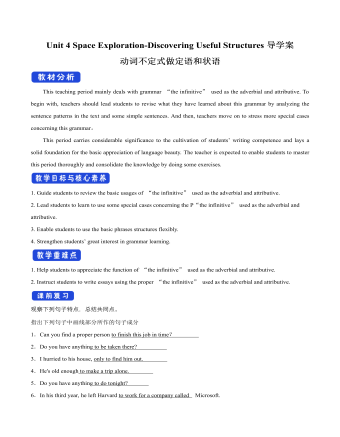
新人教版高中英语必修3Unit 4 Space Exploration-Discovering Useful Structures导学案
【点津】 1.不定式的复合结构作目的状语 ,当不定式或不定式短语有自己的执行者时,要用不定式的复合结构?即在不定式或不定式短语之前加 for +名词或宾格代词?作状语。He opened the door for the children to come in. 他开门让孩子们进来。目的状语从句与不定式的转换 英语中的目的状语从句,还可以变为不定式或不定式短语作状语,从而使句子在结构上得以简化。可分为两种情况: 1?当目的状语从句中的主语与主句中的主语相同时,可以直接简化为不定式或不定式短语作状语。We'll start early in order that/so that we may arrive in time. →We'll start early in order to/so as to arrive in time. 2?当目的状语从句中的主语与主句中的主语不相同时,要用动词不定式的复合结构作状语。I came early in order that you might read my report before the meeting. →I came early in order for you to read my report before the meeting.

必修一牛顿第一定律教案
(二)?过程与方法? 4.?观察生活中的惯性现象,了解力和运动的关系? 5.?通过实验加深对牛顿第一定律的理解? 6.?理解理想实验是科学研究的重要方法? (三)?情感态度与价值观? 7.?通过伽利略和亚里士多德对力和运动关系的不同认识,了解人类认识事物本质的曲折性? 8.?感悟科学是人类进步的不竭动力
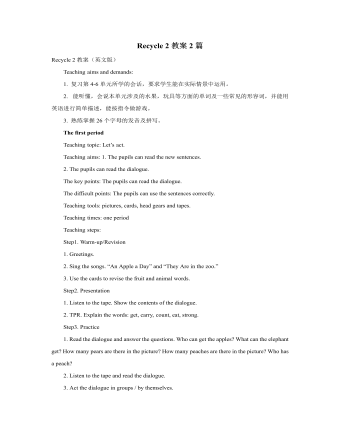
人教版新课标PEP小学英语三年级下册Recycle 2教案2篇
第三课时教学设计方案【教学内容和目标】【教学重点】 制作键盘; 学唱英文歌曲 “A B C Song ”。【教学难点】复习过程中的兴趣培养;【教具准备】1 教材配套的录音带。2 教师和学生分别准备废旧的硬纸盒/纸版、剪刀、胶水。3 教师准备一个自己已制作好的键盘。4 教师准备字母卡片和真正的键盘一个。【教学过程】1 热身、复习 (Warm-up/Revision)(1)师生之间进行英语对话或进行日常口语活动。(2)学生之间自编对话并表演。(3)教师播放B Let’s chant 的录音,让学生边拍手边说歌谣。(4)游戏:Silent Speech教师换一种方法说字母------唇说,说字母的时候不发出声音。学生看教师的口形,猜教师“说”的内容。说的字母为Aa----Zz 。2 呈现新课 (Presentation)(1)教师出示字母卡片,学生认读字母Aa----Zz。(2)学生字母背诵Aa----Zz。(3)教师播放歌曲 “A B C Song ”,告诉学生“试一试”“比一比”,看看谁能通过自己试唱学会歌曲。
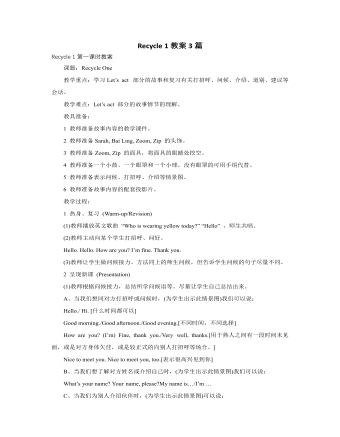
人教版新课标PEP小学英语三年级上册Recycle 1教案3篇
4 课堂评价 (Assessment) (1)做活动手册本单元第3、4、5 部分的练习。练习3是检测学生的词汇掌握情况。教师可以让学生组成两人组进行看词快说的比赛,说对一个词涂一朵小花,比谁的花多。练习4是让学生看词涂色,说说两种颜色的结合会变成什么颜色,并将第3种颜色涂在圈中。教师可以给学生做一个示范,然后再让学生动手实践。此练习是机动性练习,教师可根据时间分配情况灵活安排。练习5 是让学生将句子和相对应的图连线,教师可以先让学生看图,猜图上人说的话,然后再连线。此练习是检测学生对句子的整体认读能力,不需要学生认识句子中的每个单词。练习后,根据学生情况进行简单小结。给学生适当的奖励。(2)让学生自我评价半学期的英语学习情况,可在第37页上做标记,看看自己能达到什么程度。对于评价结果不太理想的学生,教师要及时鼓励,教育学生不能灰心放弃,针对这部分学生具体的情况在课后进行进一步交流。
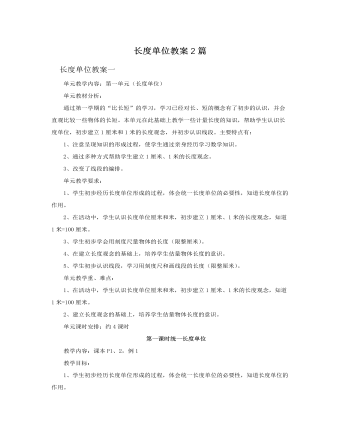
人教版新课标小学数学二年级上册长度单位教案2篇
l尺子上每相邻的两条长刻度线之间的一大格的长度都是1厘米。师:我们大家现在一起用手比划一下,1厘米多长。互相看一下,计住了吗?闭上眼睛想一想,1厘米有多长。3、认识几厘米师:我们现在知道1厘米有多长了,那3厘米又有多长呢?师:同学们还能在尺子上找到其他3厘米的长度吗?4、用厘米量师:刚才上课时,老师展示的2根线绳,到底哪一根长一点呢?现在,同学们先估计一下这两根线绳各自多长,然后在测量比较一下,好吗?师:结果是哪根线绳长一点呢?能说说你是怎么量的吗?三、知识拓展1、师:老师这里有一把尺子,可是它断了一节,没有刻度“0”,只剩下刻度3到刻度10,那么这把尺子能不能用来量物体的长度啊?同学们能不能帮老师想一想办法,好吗?2、其他测量长度的工具(课件展示)
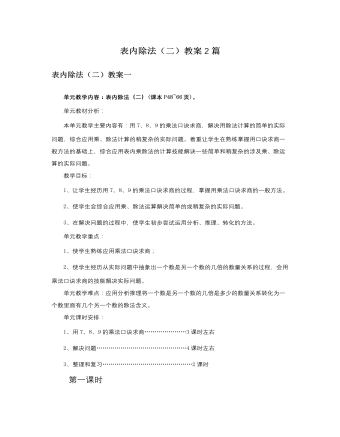
人教版新课标小学数学二年级下册表内除法(二)教案2篇
三维目标1.知识与技能(1)让学生经历用7、8、9的乘法口诀求商的过程,掌握用乘法口诀求商的一般方法。(2)使学生会综合应用乘、除法运算解决简单的或稍复杂的实际问题。2.过程与方法在解决问题的过程中,让学生初步尝试运用分析、推理和转化的学习方法。3.情感、态度与价值观让学生在学习中体验到成功的喜悦,增强学生学好数学的信心。重、难点与关键1.重点:使学生熟练应用乘法口诀求商,经历从实际问题中抽象出一个数是另一个数的几倍的数量关系的过程,会用乘法口诀求商的技能解决实际问题。2.难点:应用分析推理将一个数是另一个数的几倍是多少的数量关系转化为一个数里面有几个另一个数的除法含义。3.关键:以解决问题为载体,培养学生的数感。

人教版新课标小学数学三年级上册多位数乘一位数教案2篇
教学内容:口算乘法教学目标:使学生加深对乘法含义的理解,让学生知道生活中处处有乘法。教学重点:通过观察能熟练用乘法问题。教学过程:一、复习。6×48×59×77×56×89×7二、结合生活情况使学生加深体会乘法的含义。1、教学p68的主题图。(1)、让学生独立观察教科书p68中情境图。思考:①、这幅画面是什么地方?②、你发现了画面中有什么游戏项目。(2)、在小组中互相说说自己观察到了什么内容。(3)、各小组代表汇报。(4)、教师板书学生汇报的数据。(5)、师:根据你们提供的信息(条件),你能提出用乘法计算的问题吗?大家在小组里议一议。2、感知生活中有乘法。(1)、学生汇报。(略)(2)、师:这些活动,你们在哪亲身体验过呢?3、体会生活中的数学问题。师:除以上这些数学问题,你们谁还能提出其他的数学问题,并使用乘法计算?学生通过思考,自由回答。
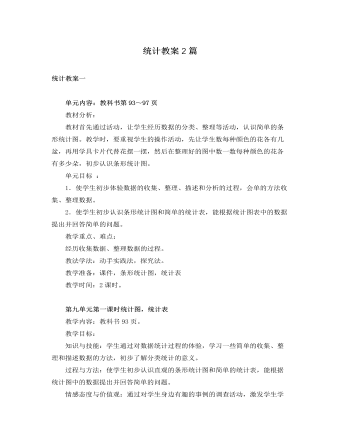
人教版新课标小学数学一年级下册统计教案2篇
2、揭题:小朋友们,知道吗?刚才你们的学习过程其实就是统计的过程,这节课我们就一起来研究统计的有关知识。3、发统计图和统计表:根据你刚才收集的数据,完成统计图和统计表。实践活动(调查全班小朋友们喜欢的动物)统计表:(学具卡片)绿孔雀非洲象大熊猫袋鼠梅花鹿河马统计图:(学具卡片)绿孔雀非洲象大熊猫袋鼠梅花鹿河马4、出示统计图和统计表。(1)通过小朋友们的统计,你能发现什么?(2)你可以提出什么问题?三、总结:1、日常生活中有许多事情可以用统计解决,你能说一说吗?2、谈谈这节课你的收获。作业布置:第二课时、练习教学内容:完成练习十七的2——4题。教学目标:巩固本单元所学的内容。教学过程:一、检查作业:1、小组互相交流自己调查的结果。2、展示几份。二、练习:练习十七1、第2题。(1)看图,明确题意。(2)先用自己喜欢的方法统计。(3)完成统计表及问题。(4)集体订正。
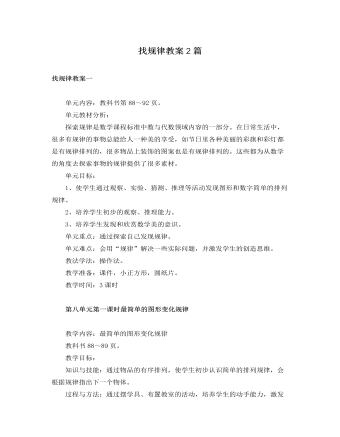
人教版新课标小学数学一年级下册找规律教案2篇
教学内容:教科书91页。教学目标:1、使学生通过观察、实验、猜测、推理等活动发现数字简单的排列规律。2、培养学生初步的观察、推理能力。3、培养学生发现和欣赏数学美的意识。教学重点:通过探索自己发现规律教学难点:会用“规律”解决一些实际问题,并激发学生的创造思维。教学过程:一、揭题:小朋友们,上节课我们不仅探索了有关图形的规律,而且还探索了有关数字的规律,这节课我们继续来学习。二、探索新知:1、学习例7。(1)小组合作学习例7,你们能发现什么规律?(2)学生小组活动。(3)汇报交流:第1组都是加1,第2组都是加2,第三组也是加2。2、学习例8。(1)小组合作学习例7,你们能发现什么规律?(2)学生小组活动。(3)汇报交流:第1组都是加5,第2组都是加3。三、完成做一做。四、学生创造性地思考其他有规律的数字排列。五、总结:通过这节课的学习,你有什么收获?作业布置:
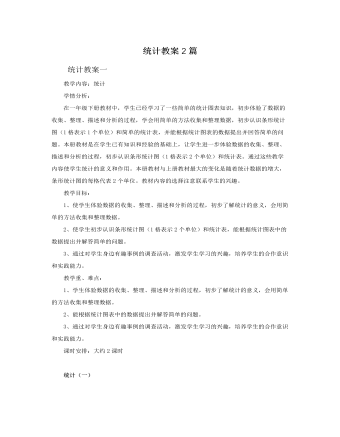
人教版新课标小学数学二年级上册统计教案2篇
1、让学生仔细观察,练习二十二1题图,你看到了什么?生:举手自由口答。2、师:根据这些信息,你能提出什么问题?板书学生提出问题在此基础上,师生重点解决问题3、小黑板出数统计表、统计图(1)学生在树上独立完成(2)上台展示并回答问题(3)师质疑:你还能提出哪些问题?[设计意图]:通过统计停车场每种车的数量,把解决问题和统计知识综合进来,巩固所学统计知识和解决问题,体验怎样收集信息。二、生活应用1、出示97页2题(1)同桌观察理解(2)独立在书上完成2、互相纠错评价,教师巡视辅导。3、质疑:你还能提出什么问题?[设计意图]:让学生通过数“正”字来收集信息。三、开放实践1、p97页3题4题(1)学生以小组为单位展开讨论统计。(1、2、3组做3题,4、5、6组做4题)(2)展示师生互评[设计意图]:让学生发挥主体性去调查收集数据,根据自己的能力提出并回答一些问题。
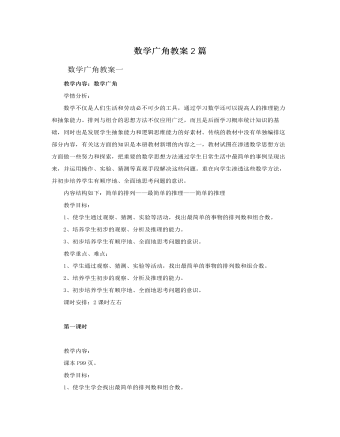
人教版新课标小学数学二年级上册数学广角教案2篇
方法三:我先把数字1放在个位,然后把数字2和3分别放在十位组成21和31;我再把数字2放在个位,然后把数字1和3分别放在十位组成12和32;我再把数字3放在个位,然后把数字1和2分别放在十位组成13和23,一共摆出了6个两位数。(21、31、12、32、13、23)每种方法说完后师问:还能摆吗?(再摆就要重复了!提示:不能遗漏也不能重复)师小结:排数的时候按照一定的顺序既不会重复也不会遗漏。我们用3个不同的一位数拼成了几个不同的两位数?(板书:6个)可拓展:三只动物抽到卡片后最多能组成21、31、32那谁可以和聪聪一起坐呀?小猫很幸运,他抽到了2和3,那么他一定会摆出一个……(三)握手小动物们谢谢我们帮他们一起解决了这些数学问题,一定要让老师表示谢意,好谢谢你们。(老师过去和学生握手。分别找几个人握手,让学生观察,每两个人握一次手。)
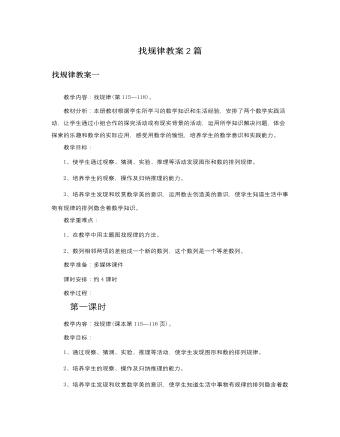
人教版新课标小学数学二年级下册找规律教案2篇
1.动物园里举行运动会,小动物可高兴了,你瞧,他们排着整齐的队伍走出来了。老师分步出示图片,让学生观察,你发现了什么?第一步逐一贴出图片;小熊、兔子、猴子、青蛙;第二步逐一贴出图片:兔子、猴子、青蛙、小熊;第三步逐一贴出图片:猴子、青蛙、小熊、兔子;第四步怎样贴呢,学生试贴:青蛙、小熊、兔子、猴子。教师:为什么这样贴呢?说出你的理由。2.观察整幅方阵图,你们发现了什么?3.请四个学生上台问及此事,做类似方阵图中动物的排列,四位同学不停的变换位置。(体会其中循环排列的含义)教师:深入观察,你们还发现了什么?教师:刚才同学们用自己的语言形容出其中的排列规律;我们可以说这种排列方式是循环排列的规律。4.小东家搞装修,房子是怎样布置的呢?我们一起参观参观,有什么规律呢?学生讨论讲解:墙面与地面都是循环排列的规律。
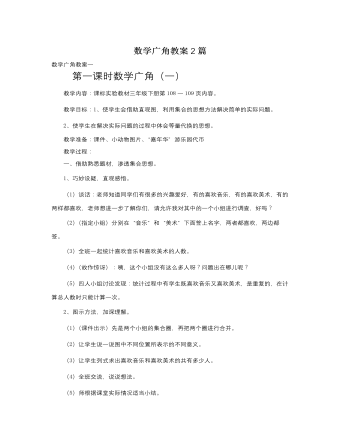
人教版新课标小学数学三年级下册数学广角教案2篇
1、同学们都听说过“曹冲称象”的故事吧!曹冲是怎么称出大象的重量的呢?让我们一起来回顾这一过程。2、曹冲是把大象的重量转换成了什么的重量呢?【他是把大象的重量转换成了与它重量相等的石头的重量】因为当时没有那么大的称能直接称出大象的重量,所以曹冲就用石头的重量代换了大象的重量,称出了石头的重量也就知道了大象的重量。3、同学们,你们大概还不知道吧,曹冲确实非常了不起,他运用了一种重要的数学思考方法——等量代换。【板书:数学广角——等量代换】这节课我们就来学习如何用“等量代换”的方法解决问题。二、引导探究发现规律1、今天这节课,老师给同学们带来了神秘的礼物。猜猜,什么样的孩子能够得到它们?全班?个大组,哪组的成员在参与过程中积极主动,认真动脑思考,遵章守纪,老师就奖励这个组一个青苹果,三个青苹果可以换一个红苹果,两个红苹果可以换取一份神秘的礼物。看看哪个组能得到礼物。有信心吗?老师相信你们是最棒的。